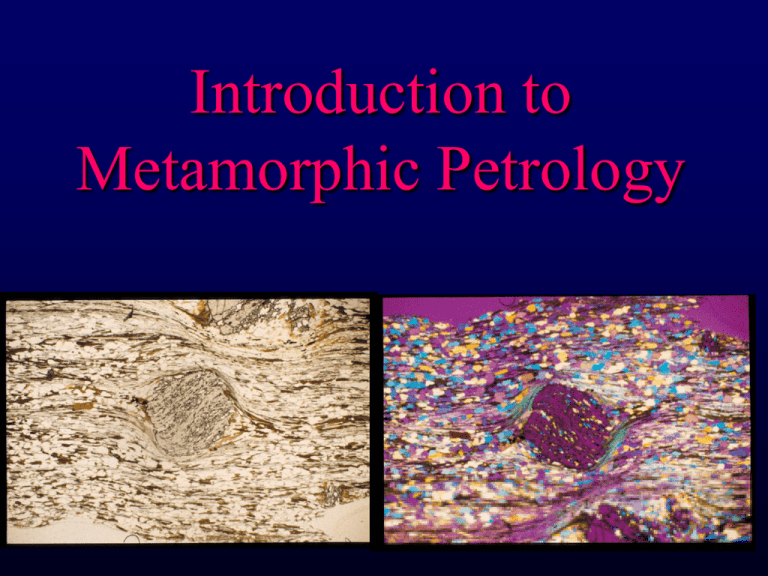Topic 8
advertisement

Introduction to Metamorphic Petrology Overview of Metamorphic Petrology • What is metamorphism and why do we care? • Metamorphism and tectonics • Metamorphic textures and what they tell us about conditions of formation • P-T environments • Metamorphic reactions, equilibrium • Controls on metamorphic reactions • Types of metamorphic rocks Review: The Rock Cycle • What is the rock cycle? • Idea that a rock (igneous, sedimentary, metamorphic) is not permanent. Igneous rocks erode to become sedimentary; sedimentary get subducted and melted….. • How do metamorphic rocks form? What is Metamorphism? Meta = change Morph = form Process by which mineralogical and/or textural change occurs in the solid state as a result of a change in P, T Why Study Metamorphism? • Interpretation of the conditions and evolution of metamorphic bodies, including mountain belts, subduction zones, cratons • Metamorphic rocks may retain enough inherited information from their protolith to allow us to interpret much of the pre-metamorphic history as well The motion of these plates is dictated largely by metamorphic petrology--principally the pressure-induced transformation of relatively low density minerals into high density minerals. How do We Study Metamorphism? • Use chemistry and physics to interpret textures and compositions of minerals field studies involve mapping, field interpretation of structure and petrology, and collection of samples laboratory investigations include crystal structure and orientation studies by diffraction of x-rays, electrons, and neutrons; texture studies by electron microscopy; and compositional studies using electron microprobe theory is based on chemistry and physics, particularly thermodynamics and kinetics experiments use high-P, high-T equipment, such as laser-heated diamond-anvil cells to mimic Earth's interior Some Background • Metamorphism is continuum between diagenesis and melting Melting is high T end (migmatite) Diagenesis is low T end Gneiss/Migmatite • • • • High-temperature limit grades into melting Over the melting range solids and liquids coexist Xenoliths, restites, and other enclaves? Migmatites (“mixed rocks”) are gradational The various plate-tectonic regimes of the Earth cause rocks to experience a broad range of pressures and temperatures, which leads to a broad range of metamorphic minerals and metamorphic rock types. stable cratons (green): cratons are stable and relatively cold, with 'normal' thermal gradients of ~20 K/km. magmatic arcs (red-orange): magmatic arcs are sites where heat is transported to shallow levels, producing low P metamorphism. continental rifts (orange): crustal extension via normal faulting leads to transport of heat to shallow levels, followed by cooling to a normal thermal gradient. subduction zones (blue): rapid subduction transports cold material into the mantle, producing high P metamorphism. Protolith!!! • What is the definition of protolith? • What are some common protoliths? We’ll return to this question in a lecture or two……. A metamorphic facies is a set of metamorphic mineral assemblages each for a specific rock compositions, that form over a specific range of P and T. Metamorphic Rocks a b Metamorphic Rocks Figure 22-1c. Garnet muscovite schist. Muscovite crystals are visible and silvery, garnets occur as large dark porphyroblasts. Winter (2001) An Introduction to Igneous and Metamorphic Petrology. Prentice Hall. Metamorphic Rocks







